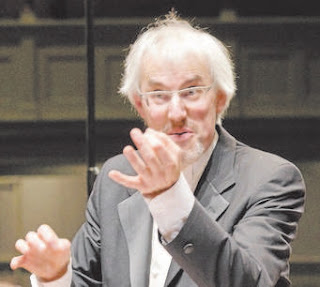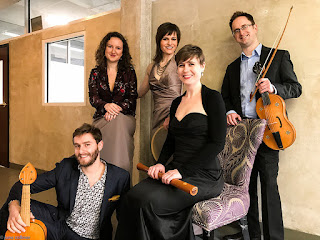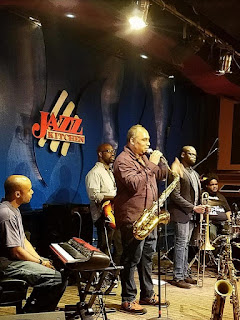Posts
Showing posts from July, 2018
It's a fine bromance, Mr. Putin conceides, despite the recurrent difficulties with Mr. Trump
- Get link
- Other Apps
'Your Tweets Too Big," Republicans in Congress cry anxiously to the President
- Get link
- Other Apps
A salute to 'Dump-D.-Trump Women,' who've had more than enough disrespect from men — from the President on down
- Get link
- Other Apps
In demand with such local colleagues as Steve Allee, Rob Dixon also partners with Charlie Hunter for "Coast to Crossroads"
- Get link
- Other Apps

Indianapolis jazz fans have listened to Rob Dixon in many musical contexts as he's made himself Shoulders hunched, brow furrowed, eyes closed, Rob Dixon lets loose indispensable on the local music scene. His funky side gets an outing with the crucial boost of Charlie Hunter , a widely known guitarist who has invited Dixon to go on the road with him after welcoming him to the Jazz Kitchen bandstand on a swing through here not long ago. Hunter produced "Coast to Crossroads," a title that exemplifies Dixon's reach (since he also has a New York sojourn on his resume). The guitarist has a crucial role introducing Dixon's original tunes (and three by others, about which more later) on this CD, along with drummer Mike Clark throughout and, on many tracks, trombonist Ernest Stuart. The CD was available when Dixon was in the front line for a performance by the Steve Allee Quartet Steve Allee Quartet plays to a full house at the Jazz Kitchen. Saturday nigh
Stalling on processing and reunifircation, the USA comes up with fear-mongering among and about immigrant families
- Get link
- Other Apps
Would or wouldn't it be nice? A song of retractable rhetoric
- Get link
- Other Apps
Would or Wouldn’t It Be Nice Would or wouldn’t it be nice if Russia Did or didn’t meddle in our stuff? Could or couldn’t we push back on Putin? Have or haven’t we just had enough? Now that he and Trump Had time together, Will or won’t we know it’s worse or better? Does or doesn’t Donald know the difference Between what isn’t and what is? Should or shouldn’t he know what he’s saying? Is or isn’t he a stable whiz? Since presidential words are consequential Knowing would from wouldn’t seems essential. Wouldn’t it be nice? Maybe if he thinks and wishes, gets things straight within his head He won’t have to say the opposite of what he clearly just said. Please or displease Putin? Make him glad or not? Time to toss the dice! We must study all his speeches to learn what each meant Till we find the grounds for Trump’s impeachment! Let’s talk about it! Oh, wouldn’t it be nice? Good night, no. 45! Sleep tight, no. 45! [repeat]
Ensemble Caprice's J.S. Bach cantatas set two spires atop the 2018 festival edifice
- Get link
- Other Apps

Concluding the 52nd annual Indianapolis Early Music Festival, Ensemble Caprice and guests from Echoing Air, an Indianapolis ensemble, and the Bach Society of Minnesota performed two cantatas Matthias Maute conducted two Bach cantatas Sunday afternoon. by J.S. Bach, "Wir danken dir, Gott" and "Lobet Gott in seinen Reichen," at the Indiana History Center Sunday afternoon. Matthias Maute, who directed the program, also was featured as recorder virtuoso in two shorter Bach works, Solo per flauto , BWV 1013, and his arrangement of the Italian Concerto, BWV 971, a work familiar in the original to pianists and harpsichordists. Maute brought to the former piece his ready command of tone, phrasing, and articulation. The interval skips in the Allemande were adroitly managed and the flow of sequences in the Corrente was poised. Expressively, the high point was the Sarabande, where just enough sostenuto lingering was evident at the slow tempo to strike the ear as mo
Will the Mueller investigation ever break, ever break, ever break Roger Stone?
- Get link
- Other Apps
Early Music Festival enters final weekend with three-concert stint by Ensemble Caprice
- Get link
- Other Apps

Thematic programming is common at the Indianapolis Early Music Festival , and none of the guest artists handle it with more conviction than Ensemble Caprice . The 2015 festival had an alluring example of that when the group was joined by soprano Esteli Gomez in repertoire exploring the interplay of the Old and the New World. Ensemble Caprice al fresco: Ziya Tabassian (from left), David Jacques, Susie Napper, Matthias Maute, Sophie Lariviere. Based in Montreal, the 25-year-old Renaissance and Baroque band on this visit opened its three-day festival run Friday night with "Chaconne: Voices of Eternity." The surprising program title alludes to the nature of the chaconne's cumulative structure. The form, based on a repeated bass figure or phrase, can go on indefinitely. There is no development; all the contrast has to be laid over the short basic line. Unlike the canon, overlapping of the generating phrase is not part of the structure, but similarly the chaconne impl
William Tatge's 'General Cargo' carries its freight with distinction
- Get link
- Other Apps

Pianist William Tatge and his New York trio display their "General Cargo." Another young jazz pianist, born abroad to American parents, steeped in classical music as well as jazz. Sound familiar? Indiana jazz fans had a chance to see the emergence of the Paris-born American Dan Tepfer as a result of his victory in the 2007 American Pianists Association jazz competition. Now comes into view William Tatge, with a trio recording called "General Cargo," released last month on Brooklyn Jazz Underground records. The Italian-born Tatge is a few years older than Tepfer, and his European foreground is much larger than the APA winner's. But he is developing an American career that has resulted in his first CD with the trio he heads in New York City. Pablo Menares is on bass, Nick Anderson on drums. "General Cargo," which represents a six-year compositional period, shows Tatge's focus on writing that eschews themes and "heads" in favor of a
Does Donald Trump need Vladimir Putin more than ever? So the Russian president sings
- Get link
- Other Apps
This side of parodies: District Theatre hosts an uproarious guest, ATI's 'Forbidden Broadway'
- Get link
- Other Apps

The old Theatre on the Square, whose checkered but often distinguished history helped Mass Ave lay claim to being an authentic cultural district, has resurfaced to maintain the neighborhood's credentials, thanks to an association with IndyFringe and support from the Central Indiana Community Foundation. To celebrate the delicate marriage, the new District Theatre has come up with a nuptial celebration bearing something old, something new, something borrowed, and something just a little bit blue: "Forbidden Broadway's Greatest Hits," a production of Actors Theatre of Indiana , a small professional company resident at Carmel's Center for the Performing Arts. The "greatest hits" addition to the familiar title indicates that ATI's show, directed and choreographed to a fare-thee-well by Billy Kimmel, is an anthology of sketches and songs from the much-revised 1982 original by Gerard Alessandrini. A lot of the show's satire takes a viewpoint fr
Cincinnati Opera's "Flying Dutchman" highlights hints of Wagner the maestro
- Get link
- Other Apps

Unlike his first big hit "Rienzi," "The Flying Dutchman" didn't seem to cause any later The Dutchman comes ashore (left) and aboard a temporarily stranded vessel and its sleeping crew. embarrassment for Richard Wagner as he advanced toward his ideal of "music drama" as the successor to the opera form he inherited. It is the earliest of his works to still hold the stage. And Cincinnati Opera' s current production of "The Flying Dutchman" looks forward to what Wagner was able to achieve in his full maturity. The set-pieces are less isolated and the odd blend of realism and the supernatural is adjusted to emphasize a symbolism that takes in the visual, dramatic, and musical integration that Wagner was working toward in the "Ring" cycle and "Tristan und Isolde." The most gripping solo in the work comes early, when the accursed title character steps ashore and informs the audience of his plight by soliloquizing on
An Early Music Festival weekend indicates the field's wide range
- Get link
- Other Apps

For the infrequent visitor to what is categorized as classical music created in the 17th century and Alkemie focused on vocal works featuring a special type of refrain. earlier, early music can easily seem like a niche, rather than a vast collection of eras and styles. That becomes evident after you get to know it. The Indianapolis Early Music Festival under Mark Cudek's direction offers a welcome refutation of a narrow view of the European musical heritage. In the weekend just ended, festival patrons at the Indiana History Center got to know medieval love songs, with Alkemie 's program "Love to My Liking: Refrains of Desire in Gothic France," and, moving two and three centuries and two days in the festival schedule forward, "For Two Lutes: Virtuoso Duets from Italy and England," with well-established masters of the instrument Ronn McFarlane and Paul O'Dette. Musicians at both concerts represent also the age spread of the field, indicating its f
Rob Dixon introduces music from his new CD at the Jazz Kitchen
- Get link
- Other Apps

Rob Dixon has built a following over the past 15 years that is more than the product of hard work and Rob Dixon talks to his public Saturday night. a willingness to be present in all sorts of musical contexts. As important as those qualities are, he exhibits ceaseless creative energy when he plays. He gets through to people. On soprano, alto, and tenor saxophones (chiefly tenor), his sound is always firmly centered, and he communicates directly in his compositions and solos. When improvising, Dixon can sometimes throw out a lot of notes, but he always eases back to a kind of simple urgency. He never seems to lose his feeling for the phrase, which makes his style accessible to jazz cognoscenti and casual fans alike. With the impending release of "Coast to Crossroads," he seems poised to widen his fan base, helped by the advocacy of Charlie Hunter, the wizard of the seven-string guitar, who produced the recording and plays on it. A preview of that disc was offered